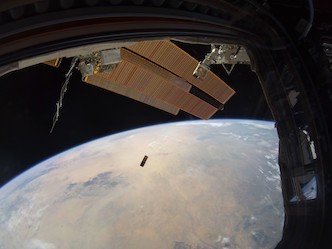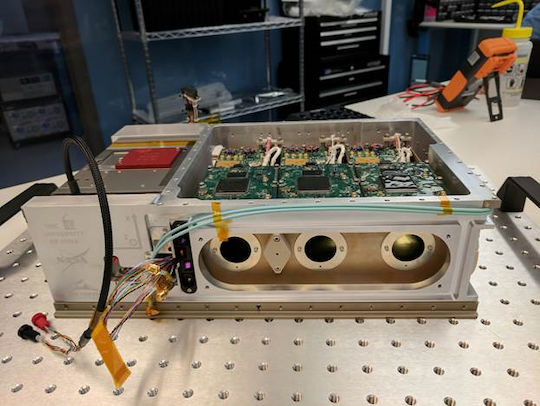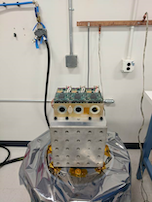|
NOTE: This is a copy of a University of Iowa web page from an obselete site, retrieved from the Web Archive archived on April 18, 2022 and retrieved on April 28, 2023. 
HaloSat re-enters the atmosphereJanuary 4, 2021On January 4th 2021, Halosat re-entered Earth's atmosphere marking the end of the satellites nearly two and a half year orbit. In that time Halosat has observed 334 fields of the x-ray sky and has produced data that has led to seven referred papers with more to come. We thank everyone for making HaloSat a success! To read more, click HERE to read a twitter thread and click HERE to read a technology note that NASA has published discussing Halosat’s impact. 
Publication: A HaloSat analysis of the Cygnus SuperbubbleDecember 20, 2020A study of the Cygnus Superbubble (CSB) using HaloSat data has been published in the Astrophysical Journal. X-ray absorption was studied in the HaloSat data for multiple CSB regions. The absorption is observed to be consistent in all regions, pointing towards the CSB being a cohesive object. The absorption is found to be most consistent with the absorption seen towards Cygnus OB1, a stellar association near the CSB. Thus, the CSB is likely at a similar distance as Cygnus OB1, of 1.1-1.4 kpc. The paper can be found HERE. 
Publication: A disk-dominated and clumpy circumgalactic medium of the Milky Way seen in X-ray emissionOctober 28, 2020Results from HaloSat on the southern Galactic halo have been published in Nature Astronomy. HaloSat measurements demonstrate strong variations in the X-ray emission on angular scales of ~10° indicating that the halo or circumgalactic medium is clumpy. The correlation of the X-ray emission with the surface density of molecular hydrogen used a tracer of star formation indicate that the X-ray emission is predominantly from hot plasma produced via stellar feedback. To read more, the paper is available HERE and some of the press coverage is available HERE . 
Daniel LaRocca PhD DefenseJuly 30, 2020Daniel LaRocca successfully defended his PhD thesis titled A HaloSat X-Ray Analysis of the North Polar Spur on July 16, 2020! He has accepted a postdoctoral position at the Eberly College of Science’s Department of Astronomy at Penn State University. Daniel will be collaborating on high energy astrophysical instrumentation projects including BlackCAT Cubesat development, novel X-ray detector development, and instrumentation for future missions. Vela SNR and Puppis A SNR indicated on a ROSAT 0.1–2.04 keV map. Silich et al. (2020) Publication: Global X-Ray Properties of the Vela and Puppis A Supernova RemnantsJune 19, 2020We’re proud to announce another Halosat publication titled Global X-Ray Properties of the Vela and Puppis A Supernova Remnants led by Undergraduate Emily Silich which was recently published in the Astronomical Journal. The paper discusses key findings in properties of the Vela Supernova Remnant including its total luminosity, temperatures, and element abundances. Halosat’s large field of view enabled us to probe the entire structure of the supernova remnant in the soft X-ray band at once, a feat which has not been done since 1999 with ROSAT. To read more click HERE. 
HaloSat X-ray spectra of Cas A in 1-3.5 keV band. Halosat: A Cubesat to Study the Hot Galactic HaloOctober 20, 2019We’re excited to announce our first HaloSat publication in The Astrophysical Journal titled: HaloSat: A CubeSat to Study the Hot Galactic Halo. In this paper, we review the science mission, design, instrumentation, on-orbit performance, and additionally provide initial observations. Our initial results demonstrate that Halosat should be effective at both constraining the spatial mass and distribution of the Milky Way’s hot Galactic halo, and also in providing unique measurements of the solar wind charge exchange emission. To read the full publication (Kaaret et al. 2019) click HERE. 
Image Credit: NASA Operations ExtensionSeptember 24, 2019The HaloSat team is excited to announce that our mission operations have been extended until June 30, 2020! HaloSat is operating well and we look to continue to observe targets in the X-ray sky. We plan to take deeper observations of the Halo of the Milky Way. We will also take more observations to characterize the X-ray emission from solar wind charge exchange as well as the diffuse X-ray emission near the galactic center. Look for more updates soon! 
Halosat One Year In OrbitJuly 13, 2019Happy Birthday Halosat! Today marks one year since our instrument was deployed from the ISS into orbit. After one year and many offerings to our Halosat Tiki, Halosat has had 612 successful observations totaling over 11 GB of data. Plotted above is our current observation data showing the number of seconds observed per target in the X-ray sky. We've completed 270/333 targets for 81% of the sky and will look to fulfill observations in the forthcoming months. 
Halosat AAS Poster PresentationsJune 10, 2019The team is headed to St. Louis, Missouri for the 234th meeting of the American Astronomical Society (AAS). Rebecca and other members are participants in the poster presentations. To view the full sized image of Rebecca’s poster click HERE. 
North Polar Spur ObservationsJune 6, 2019HaloSat has taken a series of observations of the diffuse emission of the North Polar Spur (NPS), a prominent feature in the X-ray sky. Is the NPS a feature emanating from the Galactic Center or perhaps something a bit closer to home? Observations of the NPS with the grasp and energy resolution of HaloSat should help shed light on the true nature of the object. NASA: SMALL SATELLITES YIELD BIG DISCOVERIESFebruary 4, 2019NASA ScienceCast has released a video on the role of CubeSats in recent science missions, including a dicussion on HaloSat. 
Image Credit: NASA HALOSAT NATURE ARTICLESEPTEMBER 3, 2018Nature Astronomy has published a piece about HaloSat, “Asking a big question with a small satellite.” Read the article HERE 
HALOSAT FIRST LIGHTAUGUST 18, 2018The HaloSat science instrument was turned on for the first time on-orbit on August 18. All three detectors are working great! We turned on during a pass while the instrument was pointed at the Earth’s atmosphere and the spectrum above recorded by HaloSat shows X-rays from Nitrogen and Oxygen in the atmosphere. SUCCESSFUL DEPLOYMENT FROM THE ISSJULY 13, 2018HaloSat was successfully deployed from the International Space Station July 13th, 2018 at 8:05 am GMT. We have received messages from HaloSat via the Globalstar network that show that the solar arrays deployed and the spacecraft is in Sun-pointing mode and is working just fine. 
SUCCESSFUL CAPTURE BY THE ISSMAY 24, 2018We sent a package 3-day air and space to the ISS! This morning the OA-9 S.S. J.R. Thompson Cygnus finished its journey to the ISS and was successfully captured using the ISS robotic Canadarm2 at 4:26 CDT. HaloSat has made it! Now we just need to hurry up and wait already. We are excitedly awaiting deployment from the ISS and tentatively expect to deploy around the end of July 2018. Watch the video of the capture HERE. 
SUCCESSFUL LAUNCHMAY 21, 2018Today at 4:44 am the OA-9 successfully launched with HaloSat on board! In this photo astronaut Kay Hire is holding the ‘tiki’, who has traveled with the HaloSat instrument through its various functional, thermal, and vibration tests and helps ensure that the mission is a success. This is at NASA Wallops Flight Facility on the afternoon of Sunday, May 20, before the launch of Orbital-ATK OA-9 carrying HaloSat on May 21 at 4:44 am. Tiki also watched the launch. From left to right, Daniel LaRocca, Anna Zajczyk, Phil Kaaret, Kay Hire, Will Fuelberth, Hannah Gulick, Emily Silich. Photo credit: Alexis Durow. 
ALMOST THERE!MAY 18, 2018Today the team leaves for Chincoteague, Virginia, the site of the HaloSat launch! If you are unable to attend the launch you can view the livestream beginning at 4:30 AM EDT on Sunday, May 20th here. UPDATE: Due to weather concerns the launch has been postponed 24 hours READ MORE HERE 
ARE WE THERE YET?MARCH 27, 2018Two days - that's all it takes to perform all pre-flight functionality checks and to pack a 6U cubesat into the Nanoracks dispenser. Now with HaloSat in the dispenser (phew, we did remove all the remove before flight covers!) we are all counting the days until the launch, which will happen on May 20th, 2018! 
HALOSAT FINAL X-RAY TESTFEBRUARY 23, 2018After days and weeks of spacecraft testing in various environments and configurations, the time has come to take the last X-ray spectrum with HaloSat here on the ground. So we traveled to BCT, where HaloSat currently resides, and illuminated each of the three detectors with an X-ray beam produced by COOL-X X-ray generator (left panel). And we confirmed that all is well with HaloSat - just see those titanium lines (right panel)! HALOSAT SPACECRAFT COMMUNICATIONS TESTMARCH 27, 2018This week the radio communication path between the mission operations center (BCT in Boulder, CO) the ground control station (NASA, Wallops) and the HaloSat spacecraft was tested at NASA Wallops Flight Facility. It is exciting to see the spacecraft come to life after command is issued from a control station that is miles and miles away. And even more exciting is to receive the data back from the spacecraft, so that we know that not only can we successfully upload the commands to the spacecraft, but also download the data back from it via radio. 
HALOSAT SPACECRAFT VIBRATION TESTING AT ELEMENTNOVEMBER 13, 2017This is the week when HaloSat Tiki met Nanoracks Astro Duck. And it all happened at the test facility in Longmont (CO) where HaloSat Spacecraft safely stored in a deployment container, bubble-wrapped, and strapped was subjected to vibrations,which it will see during the liftoff. The outcome - HaloSat Spacecraft passed this test with flying colors! Also Tiki and Astro Duck became best of friends. Big thank you to our BCT team, Nanoracks team and support staff at Element for all their hard work this week. 
HALOSAT SPACECRAFT INTEGRATION AT BLUE CANYON TECHNOLOGIESOCTOBER 27, 2017We’re back Boulder! Anna and Daniel drove out to BCT once again after a few weeks of hard work by the HaloSat team. Success at every step of the way. When the biggest issue is that you have to update your documentation to call your Remove Before Flight cover “Maroon” instead of “Red”, you know it has been a great trip. In all seriousness, this is a huge step for the HaloSat team and it has never felt so good to come home empty handed. Our instrument has gone off to Boulder #EmptyNesting 
SPACECRAFT INTEGRATION OF HALOSAT AT BLUE CANYON TECHNOLOGIESOCTOBER 6, 2017This week Anna and Daniel loaded Phil and the HaloSat flight equipment into the back of our rental car and drove off to Boulder. Noticed an anomaly during testing that we need to work out, but great work all around. Packed the instrument back up and took it back with us on a late night drive to Iowa with many questions to ask and answer come Monday. We’ll see you again soon Boulder. We’d like to thank everyone on our BCT team for their hard work this week! 
HALOSAT FLIGHT INSTRUMENT PRE-ENVIRONMENT VIBRATION TESTINGAUGUST 25, 2017This week, Anna and Daniel traveled out to Wallops Flight Facility amidst the rush of eclipse viewers in order to complete the pre-environmental vibration testing on our three flight detectors. The testing went as smoothly as possible, and wrapped up in just a day. Great job everyone. Let us bring HaloSat Home for some final testing. HALOSAT ENGINEERING UNIT VIBRATION TESTINGMAY 5, 2017Anna and Daniel packed up the car and drove the equipment and engineering unit 1060 miles to Wallops Flight Facility in order to perform General Environmental Verification Specification (GEVS) level of vibration testing. Running through both GEVS and Nanoracks vibration levels made the encounter take the entire allotted trip time, but we came out successful. Tested between each axis and everything came up HaloSat. Congratulations goes out to the team! Now we shift to building the flight units. IT’S ALIVEMARCH 21, 2017It may look like Phil’s Monster, but believe me when I say we are ecstatic. Today we note the first light (x-rays) on our detectors in a flight-like configuration. We may have a few connectors in places where they will not be, but it works and we are elated! Great job everyone! BCT MODEL FOR THE BUSFEBRUARY 15, 2017Looks like Will was able to set up the 3D printed model of the bus for HaloSat. You can almost start to picture the real thing! Exciting to see the Bus in person. It will find a home in the Iowa City Hawkeyes in Space Museum for now. Next stop: Space! DESIGN FOR CONNECTOR MOUNT AND WIRE ROUTINGJANUARY 18, 2017Our passive shielding is fabricated and we have assembled our detector unit in the first flight like iteration, albeit with some 3D printed parts. We’ll need to put quite a bit of “goop” on it, but it is coming together nicely. OUR DETECTORS ARE INDECEMBER 16, 2016Our three Amptek C1 SDD detectors are in and operational. We cannot wait to launch these three into space! LEGACY INSTRUMENT DESIGNNOVEMBER 4, 2016Although we have decided to opt for passive shielding, we are proud of the hard work put in on our active shielding. Here is a lovely image of an archetype of our active shield APD setup. We must retire our A225 boards. Nickle flashed, gold plated, copper tungsten here we come. J-HOOKING A DETECTOR ON OUR BASEPLATEOCTOBER 10, 2016Our detector is now attached to the “Tombstone” and our J-Hooks are in place. We have X-Rays! Base level proof of concept accomplished on. SEPTEMBER 30, 2016Completed top level fit checking with the scintillators around the detector.
|


